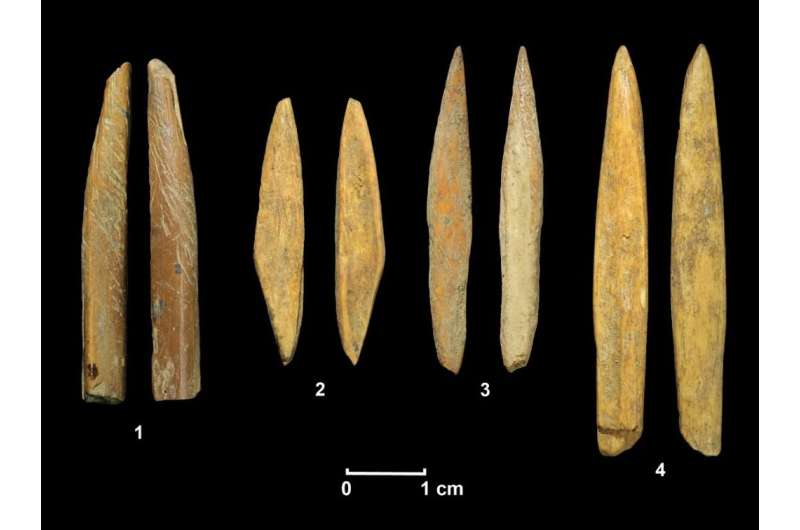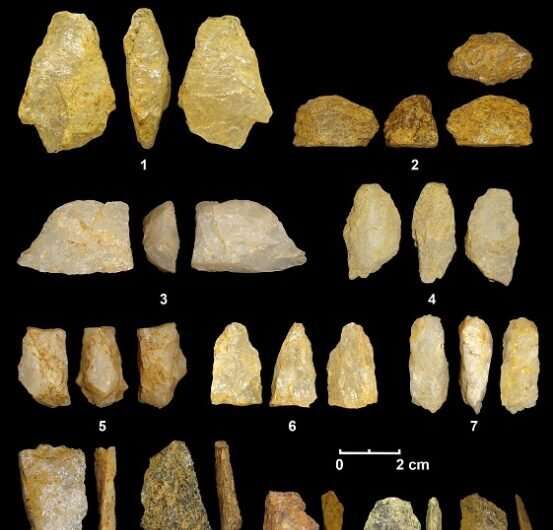Stone projectile skills helped foragers occupy rainforests during southern Asia migration

Griffith University has played a key role in new research that shows hunter-gatherers used miniaturized stone tools and bone projectile points to consistently hunt a range of animals in the Sri Lankan rainforests over the past 45,000 years.
Professor Michael Petraglia, Director of Griffith's Australian Research Center for Human Evolution is a senior author of the PLOS ONE study, led by Dr. Andrea Picin of the Max Planck Institute for the Science of Human History in Germany, and conducted in cooperation the Sri Lankan government's Department of Archaeology.
Fieldwork by the international team was conducted in one of Sri Lanka's famous cave sites, called Kitulgala Beli-lena, well-known for its rich deposits of stone tools, bone artifacts, game animals and human remains.
The researchers found long-term stability in human occupations in the wet, forested rainforest zone, ranging between 45,000 to 8,000 years ago.
This new evidence, in combination with other cave records in the region, showed the repeated and consistent settlement of the rainforest zone.
The long-term stability of rainforest occupation was based on the continuous hunting of tree- and ground-dwelling species and the collection of freshwater mollusks and wild fruits.
This research establishes Sri Lanka as one of the most important areas of human occupation over the past 45,000 years, providing key insights into how humans adapted to rainforests among a range of ecosystems as they migrated across Asia.

Professor Petraglia was one of the key Principal Investigators in the research and assembled the international team, working in collaboration with the Sri Lankan researchers and government authorities.
Lead author Dr. Andrea Picin described the new findings, including how the rainforest occupants manufactured miniaturized stone tool technologies.
Dr. Picin noted that foragers selected pebbles and cobbles from nearby streams and from there, they carefully placed the material on an anvil and struck it with a hammerstone.
The resultant small, sharp and slender pieces were then likely mounted into wooden shafts and used as projectiles to hunt prey, as supported by the presence of bone points which was used as part of bow and arrows.
Dr. Oshan Wedage, of the University of Sri Jayewardnepura, added that "tropical rainforests have been seen as ecological barriers to human migrations, but our interdisciplinary archaeological research now convincingly shows that this was not the case at all."
Instead, the discoveries showed that our species, Homo sapiens, was able to exploit challenging habitats.
Although rainforests have high biomass, the exploitation of food resources was not an easy task. Occupation of Sri Lanka's rainforest showed that foragers understood how to exploit fruits high above the ground and to deal with toxins from seeds to make them edible.
With respect to the wider message of the research, Professor Petraglia said, "The cave excavations in Sri Lanka have provided new insights into human behavior over the long-term, showing that foragers were able to adapt and survive without adversely impacting their ecosystems.
"The hunting of prey high in the trees and in dense forests required special subsistence strategies, planning and sophisticated toolkits.
"Though these hunter-gatherers became quite proficient in obtaining their dietary needs from the forest, our research shows that they did so without adversely impacting their ecosystems.
"In order not to over-exploit their local environments and food resources, foragers repeatedly moved from cave to cave, consistently shifting their residences without harming the long-term sustainability of their subsistence base."
The study, "Homo sapiens lithic technology and microlithization in the South Asian rainforest at Kitulgala Beli-lena (c. 45–8,000 years ago)," has been published in PLOS ONE.
More information: Andrea Picin et al, Homo sapiens lithic technology and microlithization in the South Asian rainforest at Kitulgala Beli-lena (c. 45—8,000 years ago), PLOS ONE (2022). DOI: 10.1371/journal.pone.0273450
Journal information: PLoS ONE
Provided by Griffith University





















